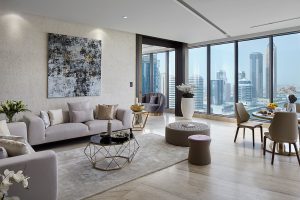Creating harmony at home through the art of interior design is a deeply transformative process that goes far beyond just arranging furniture and choosing color schemes. It is about crafting a space that not only reflects your personality and style but also nurtures your well-being and fosters a sense of tranquility. A harmonious interior design is a symphony of aesthetics, functionality, and emotional resonance. One of the key elements in achieving harmony in interior design is balance. This entails a delicate equilibrium between different design elements, such as symmetry versus asymmetry, light versus dark, and soft versus hard textures. Striking this balance allows a space to feel stable and inviting. For instance, pairing a bold, statement piece of furniture with more subtle, understated accessories can create an intriguing juxtaposition that adds character without overwhelming the senses. Similarly, incorporating a blend of natural and artificial lighting sources can create a harmonious interplay of brightness and shadow, enhancing the atmosphere within your home. Color palettes play a pivotal role in establishing harmony in interior design.

Warm tones like reds and yellows can infuse a room with energy and coziness, while cooler colors like blues and greens promote relaxation and serenity. It is essential to select colors that resonate with your personal preferences and the purpose of each room. Combining complementary colors can be a powerful tool to create harmony and interest. Whether through wall paint, furniture, or decor, a well-thought-out color scheme can set the tone for the entire space. Another crucial aspect of interior design is the seamless fusion of form and function. A beautifully designed space should not only look appealing but also serve its intended purpose effectively. This means considering the practical needs of the occupants, such as storage, seating, and workspace, while maintaining an aesthetic appeal. Clever storage solutions, ergonomic furniture, and multifunctional pieces can help streamline the design process and create a harmonious living environment. Incorporating nature into your interior design can greatly enhance the sense of harmony to Exclusive interior design trends in Houston. The use of natural materials, such as wood, stone, and plants, brings an organic, grounding element to your space.
These elements can connect your home to the outside world and evoke a feeling of serenity. Moreover, indoor plants not only contribute to improved air quality but also introduce a sense of life and vitality into the home. Harmony in interior design also relies on the principle of rhythm, which establishes a flow and continuity throughout the space. Repeating patterns, shapes, or color motifs can create a sense of unity and cohesiveness. This rhythm guides the eye smoothly through the room, creating a pleasant and engaging experience. In conclusion, interior design is more than aesthetics; it is about creating an environment that resonates with your unique personality, promotes well-being, and fosters a sense of peace and balance. Achieving harmony in your living spaces requires a thoughtful balance of design elements, a well-chosen color palette, functionality, and a connection to nature. Ultimately, the beauty of interior design lies in its ability to transform a house into a harmonious, welcoming, and inspiring home, a place where you can find solace and creativity amidst the chaos of daily life.